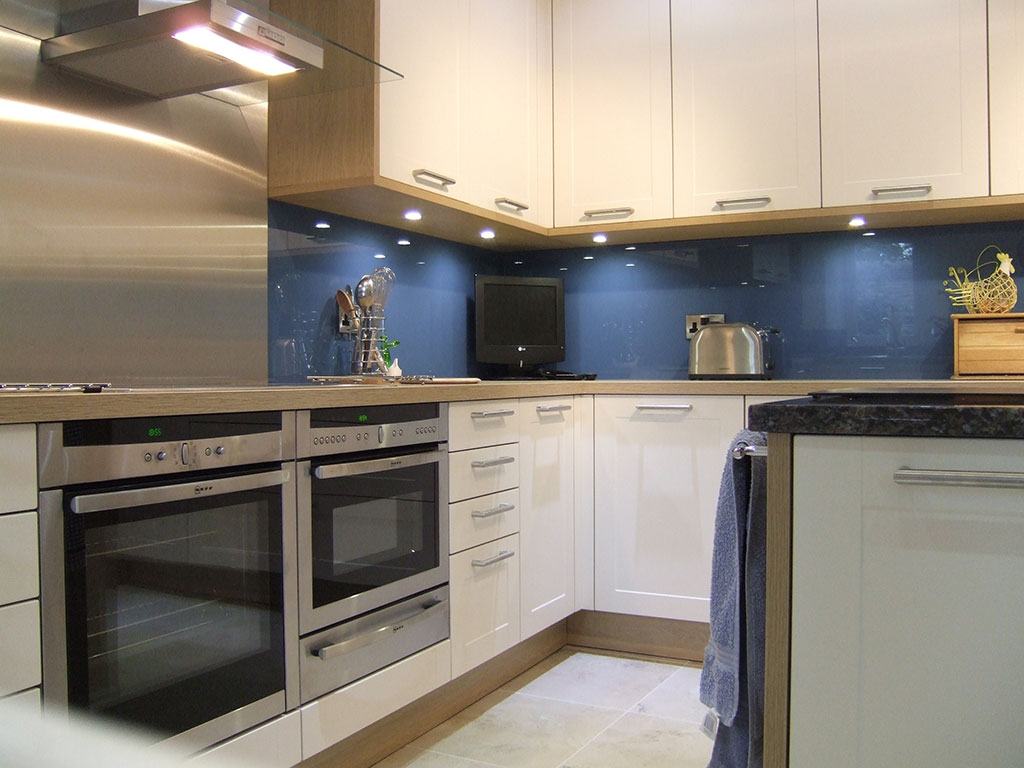Small Kitchen, Big Style: Design Tips That Maximize Space
Having a small kitchen can feel like a real challenge. You know, limited counter space, a tiny oven, and hardly any room for your stuff. But don’t worry, even with these issues, there are smart ways to make your kitchen feel much bigger and look great. It’s all about using some clever Kitchen Design tricks. We’re talking about making the most of every inch, from the floor to the ceiling, to turn that small space into something stylish and functional. So, let’s look at some ideas that can help your compact kitchen feel open and inviting.
Key Takeaways
- Use all available vertical space, like extending cabinets to the ceiling or adding open shelves, to maximize storage and make the room feel taller.
- Choose light colors and reflective surfaces to make your kitchen appear brighter and more open.
- Pick furniture that doesn’t look too heavy, and think about open layouts to create a sense of more space.
- Install built-in organizers and use corner areas to keep things tidy and make the most of every storage spot.
- Improve both natural and artificial lighting, including under-cabinet lights, to brighten the space and create a welcoming mood.
Maximize Vertical Space
Small kitchens often feel cramped, but the good news is you can make them feel bigger without knocking down walls. The trick? Thinking vertically. Don’t just focus on the floor space; look up! There’s a whole world of storage and design possibilities waiting above your head.
Extend Cabinets to the Ceiling
This is probably the most impactful thing you can do. Those awkward spaces above standard cabinets are just dust collectors. By extending your cabinets all the way up, you gain a ton of extra storage. Use it for things you don’t need every day, like holiday dishes or that bread maker you only use twice a year. It instantly makes the kitchen feel more complete and less cluttered.
Install Open Shelving
Okay, I know what you’re thinking: “Open shelving? In a small kitchen? That sounds like a disaster waiting to happen!” But hear me out. When done right, open shelving can actually make a small kitchen feel more open and airy. It forces you to be more selective about what you display, which can lead to less clutter overall. Plus, it’s a great way to show off your favorite dishes or plants. Just make sure to keep it tidy!
Utilize Wall-Mounted Storage
Think beyond just shelves. There are so many cool wall-mounted storage options out there these days. Pot racks, knife strips, spice racks – the possibilities are endless. These solutions free up valuable counter and drawer space, making your kitchen more functional. Plus, they can add a touch of personality to your walls. I recently installed a magnetic knife strip, and it’s been a game-changer. No more rummaging through a drawer full of knives!
Vertical space is often overlooked in small kitchens, but it’s a goldmine of potential. By maximizing this space, you can create a kitchen that’s both functional and stylish, no matter how small it is. It’s all about thinking creatively and making the most of what you have.
Clever Color Schemes
Color can be a game-changer in a small kitchen. It’s not just about aesthetics; it’s about creating the illusion of more space and a brighter, more inviting atmosphere. Let’s explore some clever ways to use color to your advantage.
Embrace Light and Bright Hues
Light colors are your best friend in a small kitchen. They reflect light, making the space feel larger and more open. Think about it: dark colors absorb light, which can make a small room feel cramped and gloomy. Soft whites, creams, pale blues, or greens are ideal. These hues reflect light, create a sense of openness, and add a calming atmosphere without overwhelming the space. For small kitchens, these colors are ideal.
Use Monochromatic Palettes
A monochromatic color scheme – using different shades and tints of a single color – can create a sense of harmony and visual continuity. This approach minimizes visual clutter, making the space feel more expansive. For example, you could use a light gray for the walls, a slightly darker gray for the cabinets, and stainless steel accents to add depth without breaking the color flow. It’s all about creating a smooth, uninterrupted visual experience.
Incorporate Reflective Surfaces
Reflective surfaces, like glossy paint, metallic backsplashes, or even mirrored cabinet doors, can bounce light around the room, instantly brightening and expanding the space. A mirrored backsplash, for instance, can double the perceived size of your kitchen. Just be mindful of what the mirror is reflecting – you want to reflect something visually appealing, not a cluttered countertop! Also, consider the maintenance; glossy surfaces can show fingerprints and smudges more easily, so be prepared to wipe them down regularly.
Using a limited color palette can also help to reduce visual clutter. When everything is in a similar color family, the eye isn’t drawn to different elements, creating a more cohesive and spacious feel. This doesn’t mean you have to stick to just one color, but rather choose a few complementary colors that work well together.
Strategic Layout and Furnishings
When space is tight, how you arrange your kitchen and what you put in it makes a huge difference. It’s not just about squeezing things in; it’s about making the most of every inch you have. Think about how you move around the kitchen and what activities you do most often. This will help you decide on the best layout and furniture choices.
Opt for Visually Lightweight Furniture
Bulky furniture can make a small kitchen feel even smaller. Instead, look for pieces that are visually lighter. What does that even mean? Think chairs with thin metal legs instead of solid wood ones, or a glass-topped table instead of a heavy wooden one. Clear or light-colored furniture can also help create the illusion of more space. It’s all about tricking the eye into seeing more openness.
Consider Open Plan Concepts
If possible, think about opening up your kitchen to the adjacent living area. This doesn’t always mean knocking down walls, but even creating a broken floor plan can make a big difference. An open plan allows light to flow more freely and creates a sense of spaciousness. Plus, it’s great for entertaining! You can chat with guests while you cook, making the whole experience more social.
Optimize Countertop Space
Countertop space is prime real estate in any kitchen, but especially in a small one. Think about ways to maximize every square inch. Consider built-in cutting boards that slide out when you need them, or a rolling cart that can be used as extra prep space and then tucked away when not in use. Also, keep your countertops clear of clutter. The less stuff you have sitting out, the more functional space you’ll have for cooking.
A well-organized countertop is a happy countertop. It’s amazing how much bigger your kitchen feels when you’re not constantly battling piles of stuff. Take a few minutes each day to put things away, and you’ll be surprised at the difference it makes.
Smart Storage Solutions

Okay, so you’ve got a small kitchen. Big deal! It just means you need to get smart about how you store things. It’s all about maximizing every nook and cranny. Let’s dive into some ideas that can seriously change the game.
Integrate Built-In Organizers
Think beyond just shelves. We’re talking pull-out drawers in cabinets, spice racks built into the side of cabinets, and even hidden compartments. These organizers make it easy to see what you have and prevent things from getting lost in the back.
- Custom dividers for drawers: Keep utensils, cookware, and even food storage containers neatly separated.
- Pull-out shelves: Great for accessing items in deep cabinets without having to reach and rummage.
- Vertical dividers for baking sheets and cutting boards: Stop the avalanche of falling bakeware!
Utilize Corner Storage
Corners are notorious for being dead space. But not anymore! There are some cool solutions out there to make the most of them. A corner appliance garage can hide away your blender or toaster when they’re not in use.
- Lazy Susans: These rotating shelves are perfect for storing spices, oils, and other small items.
- Corner drawers: Specially designed drawers that fit into corners, providing surprisingly ample storage.
- Angled cabinets: Maximize space and accessibility in those tricky corner spots.
Declutter Regularly
This might seem obvious, but it’s the most important thing. No matter how many fancy organizers you have, if you’re holding onto stuff you don’t need, your kitchen will still feel cramped. Get rid of anything you haven’t used in six months. Seriously.
- Donate unused appliances or cookware.
- Toss expired food items.
- Re-evaluate what you really need versus what you just want.
I know, I know, decluttering is a pain. But trust me, it’s worth it. A clutter-free kitchen is a happy kitchen. Plus, it makes cooking so much easier when you can actually find what you’re looking for!
Illumination and Ambiance
Lighting can really make or break a small kitchen. It’s not just about seeing what you’re doing; it’s about creating a space that feels good to be in. Think about how different types of light affect your mood and how you can use that to your advantage in your kitchen design.
Enhance Natural Light
Natural light is your best friend in a small space. It makes everything feel bigger and brighter. If you’re lucky enough to have windows, maximize them! Keep window treatments minimal – sheer curtains or blinds that let light filter through are ideal. Avoid heavy drapes that block light. If privacy is a concern, consider frosted glass or window film that still allows light to pass through.
Layer Artificial Lighting
Don’t rely on a single overhead light. Layering different types of artificial light is key. Think about task lighting for food prep areas, ambient lighting to create a warm glow, and accent lighting to highlight certain features. Pendant lights over an island or breakfast bar can add both style and function. Recessed lighting is great for general illumination without taking up visual space.
Add Under-Cabinet Lighting
Under-cabinet lighting is a game-changer in any kitchen, but especially in a small one. It illuminates countertops, making food prep easier and safer. Plus, it adds a nice ambient glow that makes the kitchen feel more inviting. LED strip lights are a popular choice because they’re energy-efficient, easy to install, and provide a bright, even light. You can even get them with dimmers to adjust the brightness to suit your mood.
Good lighting is so important. It can completely change the feel of a room. I remember when I added under-cabinet lights to my own kitchen, it was like night and day. Suddenly, the whole space felt bigger and more functional. It’s a small change that makes a big difference.
Thoughtful Material Choices

Choosing the right materials can make a huge difference in how your small kitchen feels. It’s not just about looks; it’s about how the materials function and how they contribute to the overall sense of space. You want things that are easy to clean, durable, and visually appealing without overwhelming the area. Let’s explore some smart choices.
Select Seamless Countertops
Opting for seamless countertops can create a cleaner, more expansive look. Fewer breaks in the surface mean less visual clutter, which is especially important in a small kitchen. Think about materials like quartz or solid surface, which can be installed with minimal seams. This not only looks better but also reduces places where dirt and grime can accumulate. I’ve found that a continuous surface makes the kitchen feel much more open and easier to maintain. A butcher block top will add a rustic note.
Choose Consistent Flooring
Flooring can really tie a room together, or it can chop it up and make it feel smaller. In a small kitchen, consistency is key. If possible, use the same flooring that’s in an adjacent room to create a sense of flow. If that’s not possible, choose a flooring material and color that complements the rest of the kitchen without being too busy. Large format tiles can also help to make the space feel bigger because there are fewer grout lines.
Incorporate Mirrored Accents
Mirrors are a classic trick for making spaces feel larger, and they work just as well in the kitchen. A mirrored backsplash, for example, can reflect light and create the illusion of more space. You don’t have to go overboard – even small mirrored accents, like cabinet doors or decorative items, can make a difference. Just be mindful of what the mirror is reflecting; you want it to be something visually appealing, not a cluttered corner. To make small kitchens appear larger, designers suggest using high-gloss paint and shiny backsplashes to reflect light.
When selecting materials, always consider the overall aesthetic you’re aiming for. A cohesive design will make your small kitchen feel intentional and well-planned, rather than cramped and cluttered. Think about how each material interacts with light, color, and texture to create a space that’s both functional and beautiful.
Making the Most of Your Small Kitchen
So, there you have it. Even if your kitchen is on the smaller side, you don’t have to give up on having a nice, useful space. It’s all about being smart with what you’ve got. Think about how you use the room every day. A little planning, some clever storage, and picking the right colors can really make a difference. You can totally turn that tiny kitchen into a place you love to be in. It just takes a bit of thought, and you’ll be surprised at how much bigger it feels.
Frequently Asked Questions
How can I make my small kitchen look larger?
To make a small kitchen feel bigger, use light colors on walls and cabinets. Add mirrors or shiny surfaces. Also, make sure there’s good lighting. Think about using furniture that doesn’t look heavy, like chairs with thin legs.
What are some smart ways to add storage in a tiny kitchen?
You can get more storage by using tall cabinets that go all the way to the ceiling. Put up shelves on the walls. Also, use organizers inside your drawers and cabinets to keep things tidy. Don’t forget about hooks for hanging things.
What colors work best for small kitchens?
The best colors for a small kitchen are light ones, like white, cream, or light gray. These colors reflect light and make the space feel open and airy. You can also use one color in different shades for a smooth look.
Does lighting really matter in a small kitchen?
Yes, good lighting is very important! It makes the kitchen feel more open and welcoming. Try to let in as much natural light as possible. Also, add different types of lights, like lights under cabinets and ceiling lights, to brighten up every corner.
What kind of furniture should I choose for a small kitchen?
When picking furniture, choose pieces that are not too big or bulky. Look for items with open designs, like tables with thin legs, so you can see through them. This helps the room feel less crowded.
How can I make my small kitchen more functional?
You can make your small kitchen more useful by getting rid of things you don’t need. Use smart storage solutions, like pull-out shelves or corner cabinets. Also, keep your countertops clear by storing appliances away when you’re not using them.





Leave a Reply
Want to join the discussion?Feel free to contribute!